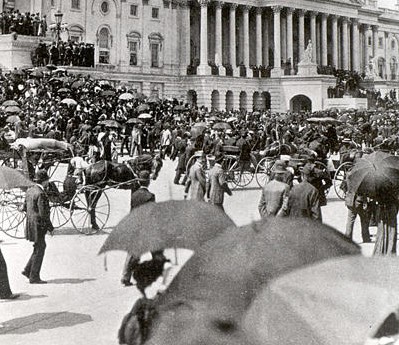 Once again, DC has survived another march – this time by those demanding immediate action on the imminent threat of global warming. Activists from around the country, some 35,000 strong, gathered near the Washington Monument to propound their views. It is an activity that is explicitly allowed in the first amendment of the constitution, and thus as old as the country. The first major gathering in DC is, of course, not as old, but is still over 120 years old.
Once again, DC has survived another march – this time by those demanding immediate action on the imminent threat of global warming. Activists from around the country, some 35,000 strong, gathered near the Washington Monument to propound their views. It is an activity that is explicitly allowed in the first amendment of the constitution, and thus as old as the country. The first major gathering in DC is, of course, not as old, but is still over 120 years old.
In 1893, an economic panic swept through the nation, throwing millions out of work and leaving the country in a precarious position. It was the worst depression the country had seen up until then, and many felt that it was time to change the way that the country operated. One of these was Jacob Coxey, who was a small business owner that had suffered due to the panic, and felt that the government should do more to help those who had lost their livelihoods due to the crash. In particular, he felt that there should be a huge number of public works organized in order to get people back to work, as well as buy the sandstone from his quarry.
Starting off from his hometown of Massillon, Ohio on March 24, Coxey hoped to reach DC by May. The Washington Post had heard of his plans two months earlier, and had published a short article, the headline of which called him a ‘candidate of an asylum’ and declaring it to be a ‘crazy idea.’ The article itself was far more sympathetic to the man and the movement, which probably indicates a difference of opinion between the reporter and the editor.
As the march approached Washington, however, the tenor of both the articles and the headlines begin to change, and the Post begins to treat Coxey and his army with more respect, and begins asking how the city and particularly the Capitol Police intend to deal with the situation. Major William G. Moore, of the DC police, announced that he had found four different statutes that he would use to arrest the marchers ‘just as soon as they enter the District.’
By the time the army, now 500 or so strong, reached the city limits, Moore had changed his mind. The army was allowed to camp in Brightwood, then on May 1 marched to the Capitol. They were met by some 1,500 soldiers and policement. The marchers, who had come down 14th Street NW before turning on to Pennsylvania Avenue, arrived at the base of Capitol Hill at the Peace monument, then made their way up the south side of the building to the corner of B Street (now Independence Avenue) and 1st Street SE.
At this point, the march was called to a halt, and the leaders entered the Capitol Grounds to — at the very least — present a list of demands to Congress. Behind them came their followers, who had by now descended into a mob, and the police ‘used their clubs freely’ in an attempt to stop them.
Coxey made it to the East front of the Capitol, where he hoped to give a speech. This opportunity was denied him, so he simply passed it to a nearby newspaperman. The Washington Post, in an article written in 1927, summed up the situation thus: “He had marched his army 600 miles, only to be deprived in the end of its object.”
While Coxey himself was arrested, he was not detained and, as his lieutenants were now in jail, it fell to Coxey to lead his rag-tag bunch away from the Capitol. They found refuge on M Street SW, and later near Hyattsville. Meanwhile, Coxey was sentenced to jail for 20 days, thus rendering the army entirely leaderless, and so, slowly, the members trickled away — until finally only about 80 remained, to be easily swept aside (under vagrancy laws) by the police.
And thus ended the first organized march on DC, the first major protest to end up on the Capitol grounds.

